 |
BusTalk
A Community Discussing Buses and Bus Operations Worldwide!
|
| View previous topic :: View next topic |
| Author |
Message |
Mr. Linsky
BusTalk's Offical Welcoming Committee

Joined: 16 Apr 2007
Posts: 5071
Location: BRENTWOOD, CA. - WOODMERE, N.Y.
|
 Posted: Tue Jun 02, 2009 12:27 am Post subject: Posted: Tue Jun 02, 2009 12:27 am Post subject: |
 |
|
| Mr. Linsky wrote: | The Don,
What did Raymond Loewy really know about designing a bus? (only kidding!).
If you will look more closely at the picture below, you will see that the passenger entry is located just behind the front wheel.
What appear to be windows in what would normally be the luggage section are actually seats the access to which are through that same door.
The upper level including the driver's compartment must have been gained by interior stairway.
I would imagine that the luggage would have been stored over the rear wheels.
Not to worry - this bus was never built.
Photo courtesy of Bill D.
Mr. Linsky - Green Bus Lines, Inc., Jamaica, NY
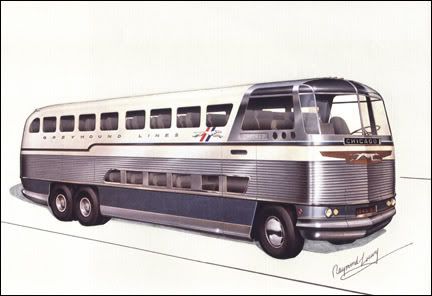 |
You'll notice that in my short essay above I mention that Raymond Loewy's prototype 'Scenicruiser' (pictured in quote) was never actually built!
Well, I was wrong!, and thanks to the Hagley Museum and Library I have found both information and a photo of the only one that was built and introduced in 1948 after three years of experimentation and design study.
The vehicle, known as the 'Highway Traveler' and built by GM Truck and Coach ran in test service for Greyhound until 1951 and featured seating for 50 passengers in three compartments within the same dimensions as a standard single level coach, a sandwich bar and a lavatory, air conditioning and the first use of genuine air suspension.
Power was derived from two rear mounted 'air cooled' 150 hp six cylinder engines combined with a mechanical transmission.
Under normal conditions, one engine drove the coach while the other generated electricity for all major accessories.
In unusual situations either or both engines could drive the coach.
I find nothing in the records to indicate that this vehicle was preserved.
Mr. Linsky - Green Bus Lines, Inc., Jamaica, NY
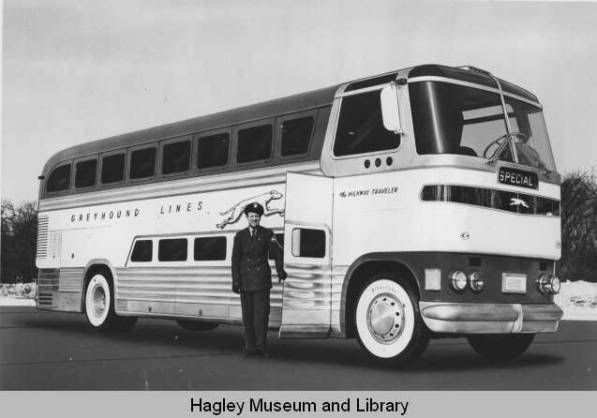 |
|
| Back to top |
|
 |
HwyHaulier
Joined: 16 Dec 2007
Posts: 932
Location: Harford County, MD
|
 Posted: Thu Jun 11, 2009 1:20 pm Post subject: Columbia Night Coach Posted: Thu Jun 11, 2009 1:20 pm Post subject: Columbia Night Coach |
 |
|
Turner Classic Movies, last night ran Sullivan's Travels (1941). See: http://www.imdb.com/title/tt0034240/
Comments on vehicles in the film, see also: http://www.imcdb.org/movie.php?id=34240
Remarkable, the movie had a great deal of assist from Southern Pacific RR. Also, and I'm guessing here, some support from Santa Fe Trails, too.
A pre-WWII Night Coach has a bit of a cameo role as a Land Yacht. The IMCDB site identifies it, and I'll submit as erroneous, as a 1933 Yellow
Coach Nite Coach.
It is no such thing. Indeed, it could be a late production Pickwick. In my estimation it is a 1934 Columbia. Site, www.coachbuilt.com, sorts it out
in entries for Pickwick...
See Photo, and all following comments: http://www.imcdb.org/vehicle_122590-Yellow-Coach-Nite-Coach-1933.html
.....................Vern.................... |
|
| Back to top |
|
 |
Mr. Linsky
BusTalk's Offical Welcoming Committee

Joined: 16 Apr 2007
Posts: 5071
Location: BRENTWOOD, CA. - WOODMERE, N.Y.
|
 Posted: Mon Jul 06, 2009 12:34 am Post subject: Posted: Mon Jul 06, 2009 12:34 am Post subject: |
 |
|
Dave L. (Cyberider) has often talked about the GM Old Looks of Pheonix that had after market air conditioners.
I found the interesting bit of information below while surfing eBay which will fill in a few of the missing pieces about those special systems.
Note that the manufacturer - Thermo King - featured the Phoenix installation in its ads.
St Louis Public Service also had these custom coolers on many of their GM Old Looks.
The only problem was that these machines worked so well that most of the drivers came to work with winter overcoats on the hottest summer days!
Mr. Linsky - Green Bus Lines, Inc., Jamaica, NY
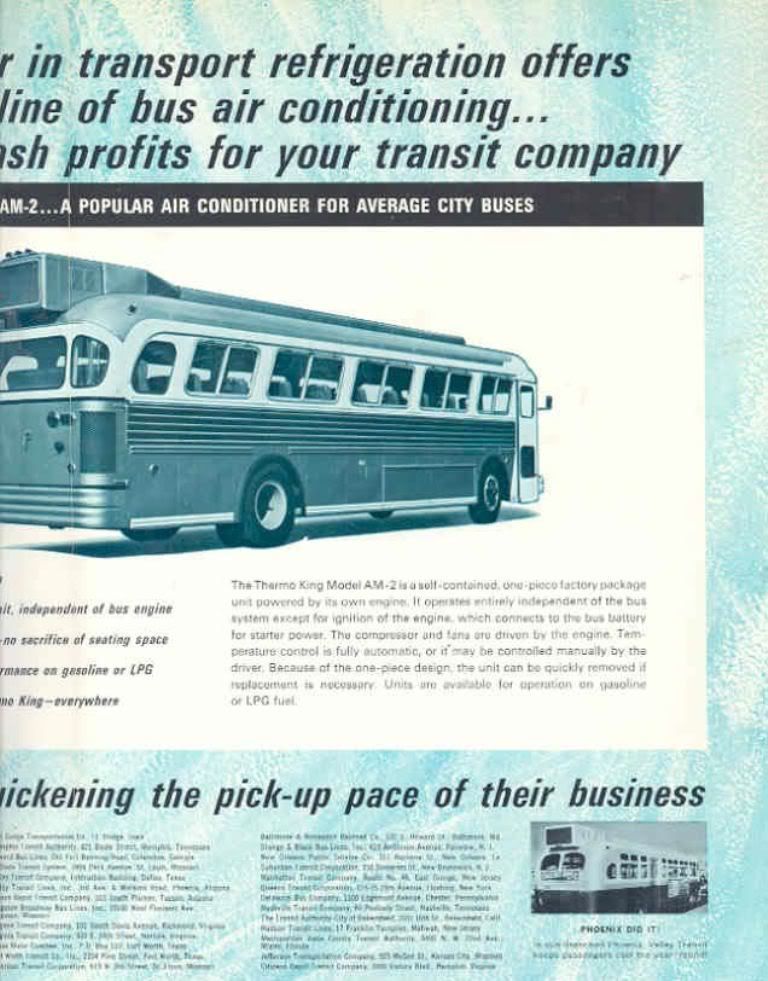
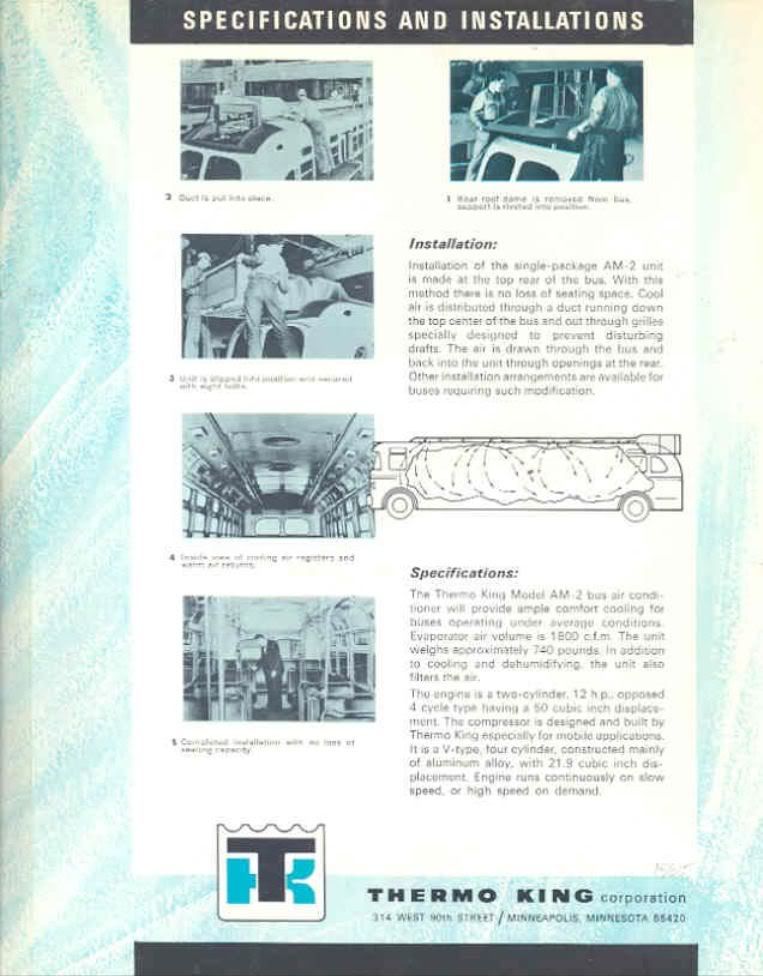 |
|
| Back to top |
|
 |
HwyHaulier
Joined: 16 Dec 2007
Posts: 932
Location: Harford County, MD
|
 Posted: Mon Jul 06, 2009 8:59 am Post subject: Posted: Mon Jul 06, 2009 8:59 am Post subject: |
 |
|
Mr 'L' -
Seems to me & (Tariff Note) IIRC, the large group of D C Transit GM TDH 51-- types (DCTS 5600 class), its initial new equipment order, ran T-K units.
The coaches the first major display of the bold, GM Design Group inspired colors. Markings displayed, ARTICOOLER...
Earlier, a similarly painted coach, a GMC T&C demo, displayed at Columbus Circle, New York. IIRC, you have (or have seen) the dramatic photos...
.................Vern................ |
|
| Back to top |
|
 |
Mr. Linsky
BusTalk's Offical Welcoming Committee

Joined: 16 Apr 2007
Posts: 5071
Location: BRENTWOOD, CA. - WOODMERE, N.Y.
|
 Posted: Mon Jul 06, 2009 2:51 pm Post subject: Posted: Mon Jul 06, 2009 2:51 pm Post subject: |
 |
|
H. H.,
DC Transit was the first operator to purchase GM Old Looks with factory air conditioning in the late 50's.
I believe the units were built by GM's Frigidaire Division.
The livery that you speak of was out of GM's Art and Design studio and did appear on the Fifth Avenue demonstrator pictured below.
DC liked the scheme so much that they were among the first operators to adopt it.
Mr. Linsky - Green Bus Lines, Inc., Jamaica, NY
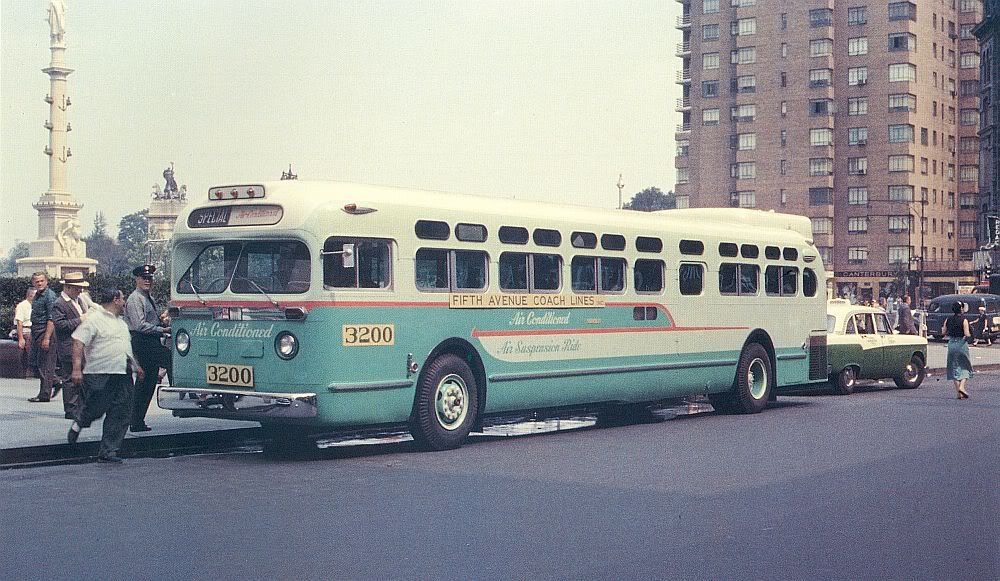 |
|
| Back to top |
|
 |
Mr. Linsky
BusTalk's Offical Welcoming Committee

Joined: 16 Apr 2007
Posts: 5071
Location: BRENTWOOD, CA. - WOODMERE, N.Y.
|
 Posted: Fri Jul 10, 2009 4:25 pm Post subject: Posted: Fri Jul 10, 2009 4:25 pm Post subject: |
 |
|
Pictured below (top) is a Yellow Coach shop drawing and spec. sheet for the model 720 and 735 Double Decker coach to be submitted for approval by the Fifth Avenue Coach Company of Manhattan, New York.
Most of the 160 buses eventually purchased were of the 735 version with a small number of 720's, and all were gasoline powered with Banker mechanical transmission with the exception of 25 test Diesels.
The 71 passenger model 720 and 735 were identical in every respect except that the 720 was 6 inches shorter to compensate for the low slung steel work of the elevated railway on the number 15 Jackson Heights route.
Due to increased maintenance costs and the proliferation of 40 foot 51 passenger single level buses in the early fifties, the double deckers saw the end of service in 1953.
Number 2124 survives and is part of the MTA Museum fleet.
Also pictured below (center of frame) is number 2050 plying its usual Manhattan route.
I would suppose that by more modern nomenclature, number 2124 would be a TDH or M 7101!
Photo credits; (top) NY Public Library Digital Gallery, (bottom) Museum of Bus Transportation, Hershey, Pa.
Mr. Linsky - Green Bus Lines, Inc., Jamaica, NY
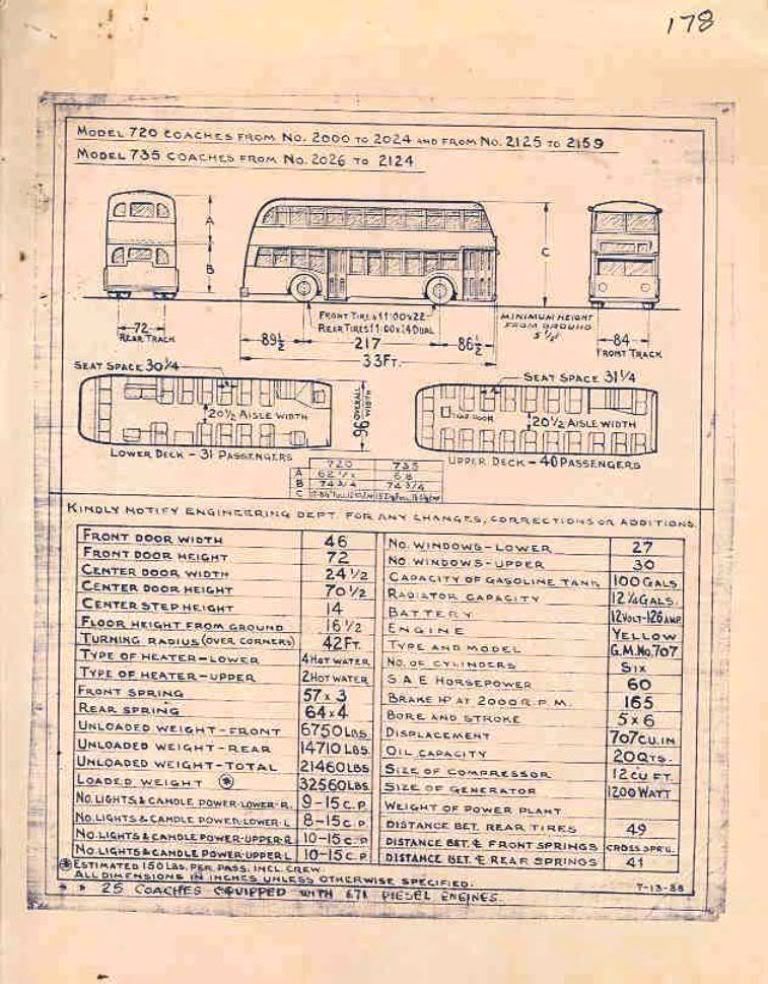
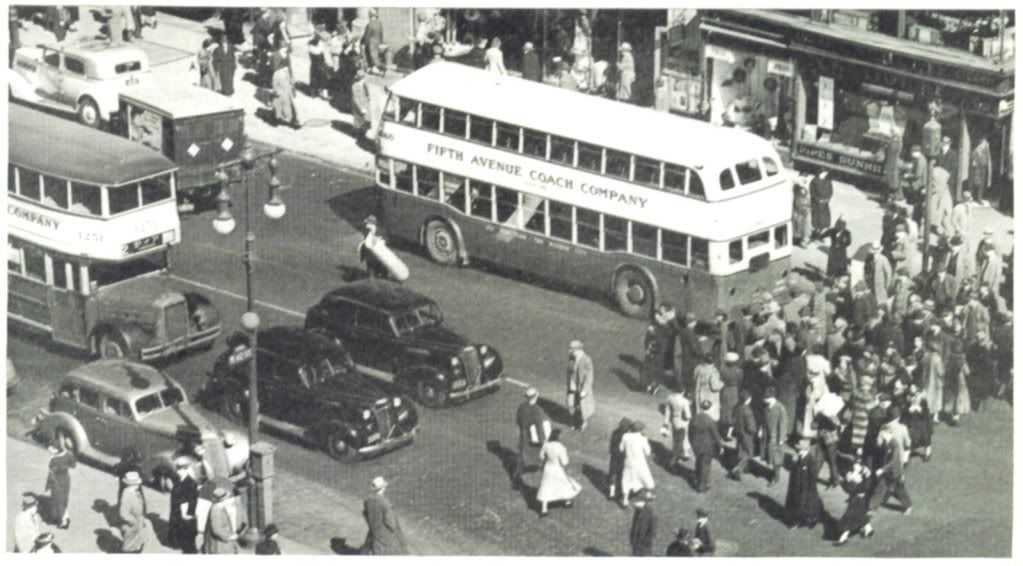 |
|
| Back to top |
|
 |
HwyHaulier
Joined: 16 Dec 2007
Posts: 932
Location: Harford County, MD
|
 Posted: Sat Jul 11, 2009 6:26 am Post subject: Posted: Sat Jul 11, 2009 6:26 am Post subject: |
 |
|
Mr "L" -
Great find! A "right good" piece of engineering, how they got it all in at a 21,460 lb. Empty Weight!
.................Vern............. |
|
| Back to top |
|
 |
Mr. Linsky
BusTalk's Offical Welcoming Committee

Joined: 16 Apr 2007
Posts: 5071
Location: BRENTWOOD, CA. - WOODMERE, N.Y.
|
 Posted: Tue Jul 14, 2009 3:38 pm Post subject: Posted: Tue Jul 14, 2009 3:38 pm Post subject: |
 |
|
Seen below, and appearing as an ad, in the October 1932 issue of 'Transit Journal' (a forerunner of 'Bus Transportation' magazine) is a Flxible 15 passenger touring coach mounted on a Buick chassis and powered by one of Buick's famed 'Fire Ball' Straight Eight engines.
A little Flxible history;
In 1912, Hugo H. Young, a Mansfield Ohio, Harley-Davidson dealer, had an idea for a new type of motorcycle sidecar suspension - one that would permit the third wheel to tilt and stay on the ground when the motorcycle leaned while going around curves either to the left or right. In order to allow the wheel's geometry to change, a "flexible" connection was required between the motorcycle and the side car. The flexible connection would also allow the sidecar's wheel to follow imperfections in a roadway's surface without affecting the motorcycle's balance. By incorporating a pivoting axle, the sidecar's wheel is made to follow the direction of the motorcycle, whether rounding turns or on a straight course.
Young built a prototype sidecar for his own use. A traveling salesman friend saw the newly designed sidecar and realizing its great possibilities, urged him to patent and manufacture the sidecar. In 1913, Young filed for a patent and subsequently organized the Flexible Side Car Company to manufacture a sidecar using the novel suspension. On April 9th 1914, Young and his partner, Carl F. Dudte, incorporated the Flexible Sidecar Co. for $25,000 in nearby Loudonville, Ohio (the name Flexible was subsequently changed to 'Flxible' for trademarking purposes).
It was not long after the company established itself in Loudonville that the production of both bus and funeral coach bodies began as well as a long relationship with the Buick Motor Car Division of the General Motors Corporation.
Flxible's arrangement with Buick spanned 40 years and included power trains for the company's well received 'Clipper' lines of the forties and fifties.
1931-1932 production was built using 104hp straight-eight Buick series 8-870 chassis. The Buick frame was purpose-built for professional car work and featured one-piece side-rails and a wheelbase of 155". A handful of Cadillac V8-chassised coaches were also built in 1932 but Buick-equipped chassis outnumbered them 100-to-1.
Flxible's foray into 'professional' car bodies ended in the early forties and its entire production was geared to building buses.
Credits; some information culled from Coachbuilt with photo found on eBay.
Mr. Linsky - Green Bus Lines, Inc., Jamaica, NY
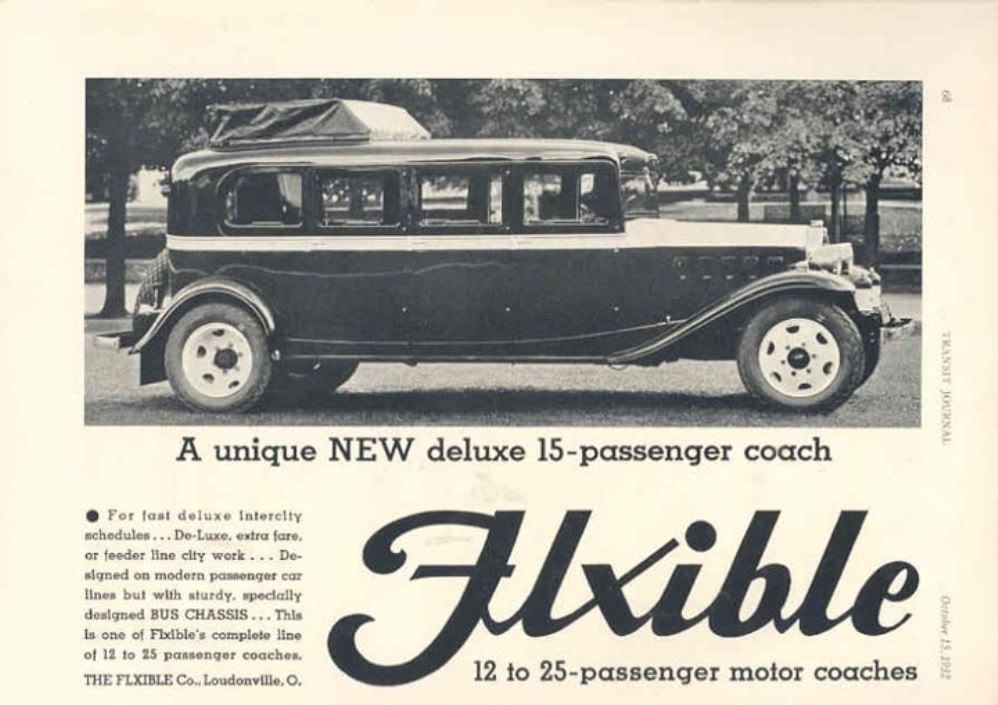 |
|
| Back to top |
|
 |
Mr. Linsky
BusTalk's Offical Welcoming Committee

Joined: 16 Apr 2007
Posts: 5071
Location: BRENTWOOD, CA. - WOODMERE, N.Y.
|
 Posted: Fri Jul 17, 2009 12:19 am Post subject: Posted: Fri Jul 17, 2009 12:19 am Post subject: |
 |
|
I have been asked by readers on another board as to how the more than 40 year relationship between Flxible and General Motors came about.
The answer lies with a fellow by the name of Charles F. Kettering (pictured below) who was a brilliant inventor and electrical engineer and who along with several friends formed the Dayton Engineering Laboratories Company (Delco) in Dayton, Ohio in 1909 where he continued work on developing a better ignition (starting system) for automobiles.
In that same year, the company received an order for eight thousand ignition systems from the Cadillac Motor Car Company which led to the creation of the electric starter that first appeared on Cadillacs in 1912 and on many other makes the following year.
Kettering and Delco also improved auto lighting systems and eventually grew to be the largest automotive accessory supplier in the country.
Charles F. Kettering's sold Dayton Engineering to General Motors in 1918 and as a major GM stockholder was subsequently able to make arrangements for his friends at Flxible to obtain new Buick chassis for their bus bodies directly from the factory.
Flxible’s bus manufacturing got off to a slow start with production in 1926 amounting to only 31 coaches and all were built on Buick commercial chassis whose wheelbases were extended up to 168".
Photo credit; GM Archives
Mr. Linsky – Green Bus Lines, Inc., Jamaica, NY
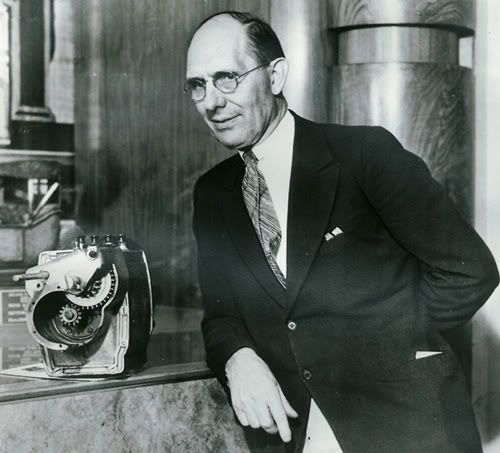
Charles F. Kettering shown with an early self starter |
|
| Back to top |
|
 |
roymanning2000
Age: 75
Joined: 01 Aug 2007
Posts: 198
|
 Posted: Fri Jul 17, 2009 7:27 am Post subject: Posted: Fri Jul 17, 2009 7:27 am Post subject: |
 |
|
Mr. L,
After Charles Kettering sold DELCO to GM, he became GM's director of research and was eventually a GM vice-president. He served in that capacity until his retirement in 1947. He continued to be a member of GM's board until his death in 1958.
At the same time, Kettering was always heavily involved with Flxible. He had become the company's first president in 1914 and became the chairman of the board in 1940. He still held that position when he died.
So he was in a pretty good position to help Flxible get all those Buick (and Chevy) engines for the Clippers and access to 4-71 Detroit Diesels for the Visicoach in the early 50's.
Roy |
|
| Back to top |
|
 |
Mr. Linsky
BusTalk's Offical Welcoming Committee

Joined: 16 Apr 2007
Posts: 5071
Location: BRENTWOOD, CA. - WOODMERE, N.Y.
|
 Posted: Mon Jul 20, 2009 1:18 am Post subject: Posted: Mon Jul 20, 2009 1:18 am Post subject: |
 |
|
Just happened upon the attachment while strolling through eBay.
It is a factory photo of a handmade Flxible Parlor Coach body mounted on a 1932 Buick commercial chassis and one of very few made during that period.
BTW; the upright cylinders just below the headlights are shock absorbers.
Enjoy,
Mr. Linsky - Green Bus Lines, Inc., Jamaica, NY
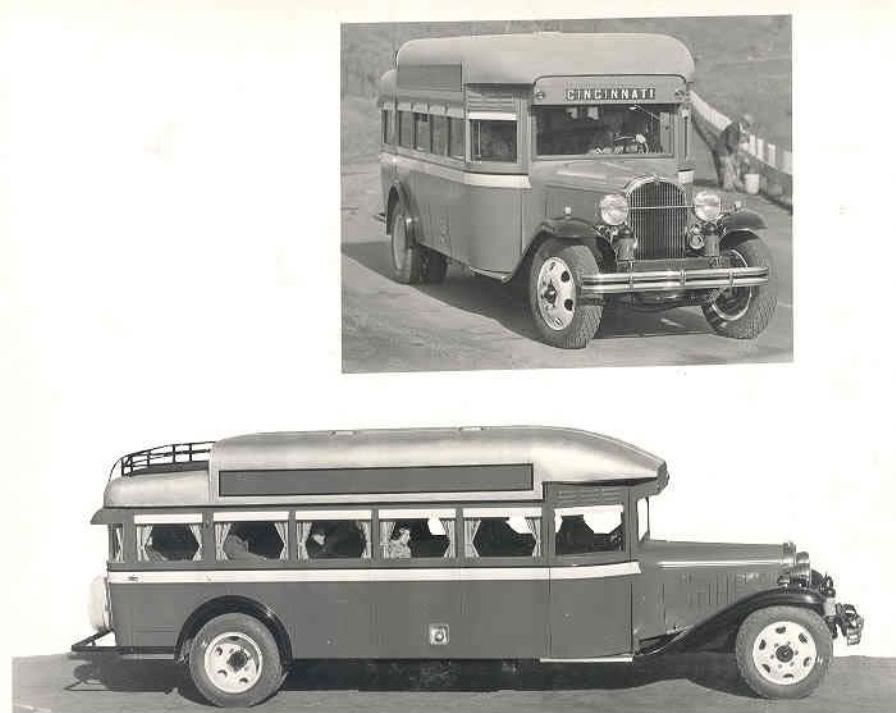 |
|
| Back to top |
|
 |
Mr. Linsky
BusTalk's Offical Welcoming Committee

Joined: 16 Apr 2007
Posts: 5071
Location: BRENTWOOD, CA. - WOODMERE, N.Y.
|
 Posted: Sun Jul 26, 2009 4:36 pm Post subject: Posted: Sun Jul 26, 2009 4:36 pm Post subject: |
 |
|
Seen below in both interior and exterior factory shots is a rare 1962 Prevost Model 49-S Transit Bus much in the character of the 'New Look' designs from both GM and Flxible of that era.
At 40 feet in length with a width of 96 inches, the 49-S carried 49 passengers and was powered by a 6-71 GM Diesel engine.
Prevost's foray into high capacity transit came to naught and only 23 of these buses were built between 1962 and 1967.
Some history of Prevost follows;
In 1924 Eugene Prevost, a cabinetmaker in the province of Quebec, Canada, built his first wooden bus body.
In 1945 the first all metal coach was built and bus building gradually became the firm's main activity. During the 1950's, however, Prevost, like many small bus builders at that time, was hard hit by declining markets and competition from GM. Only a handful of buses were built in the mid 1950's.
In 1957, Paul Normand bought the company and re-organized it. Various transit and intercity models were built with moderate success, but total production from 1943 to 1970 was less than 1000 vehicles.
The big change came with the introduction of the "Super Panoramique" over the road coaches in 1966 and the Panorama, with the characteristic curved side windows, in 1968
The rest, as they say, is history!
Photo credits; eBay
Mr. Linsky - Green Bus Lines, Inc., Jamaica, NY
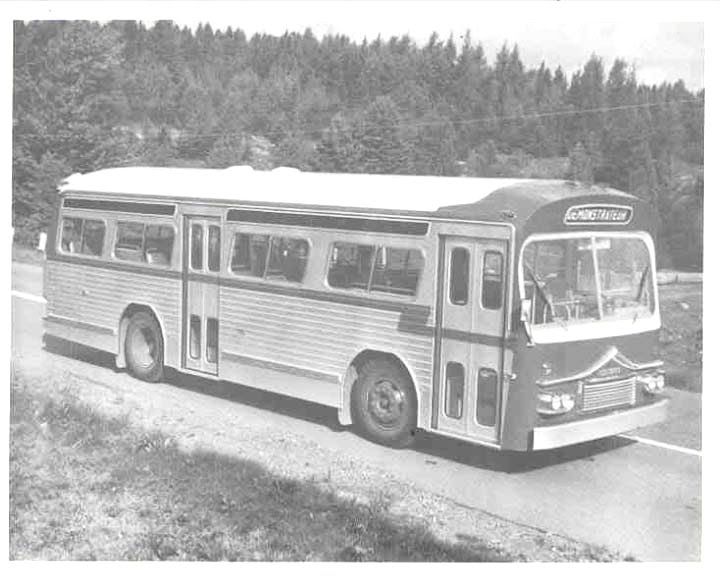
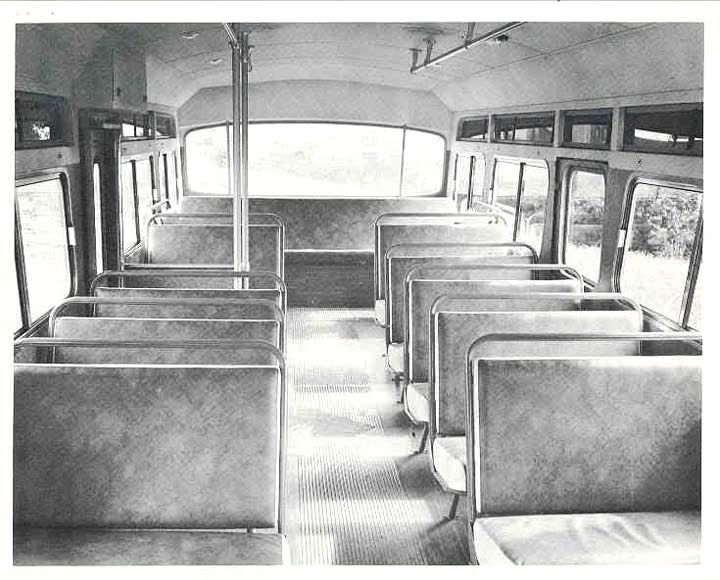 |
|
| Back to top |
|
 |
ripta42
Site Admin
Age: 45
Joined: 15 Apr 2007
Posts: 1035
Location: Pawtucket, RI / Woburn, MA
|
 Posted: Tue Jul 28, 2009 4:19 pm Post subject: Posted: Tue Jul 28, 2009 4:19 pm Post subject: |
 |
|
| Mr. Linsky wrote: | Pictured below is fleet number 6621 - a 1966 GM Coach Model SDM 5302 operating for the Bonanza Bus Lines, Inc. of Providence, Rhode Island.
Circumstantial evidence leads me to believe that this bus was originally purchased as one of four (6621 to 6624) in March of 1966 by the Short Line, Inc. also of Providence.
The fleet number probably remained the same because the first two digits of all Short Line fleet numbers denoted the year of purchase and, once resold, would have been meaningless to them. |
This bus wasn't resold to Bonanza; Short Line's name changed to Bonanza in 1970 (allegedly, the television show of the same name was owner George Sage's favorite!). However, sister coach 6623 from this order was resold and became RIPTA 4001. Three more Short Line/Bonanza SDM5302s from 1967 were also sold to RIPTA and became 4002-4004; pictured below is ex-6726 as RIPTA 4004 in 1981 (photo by RailBus63)
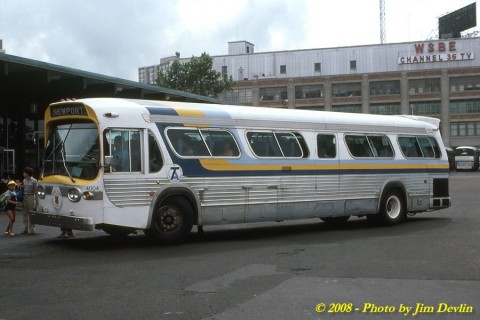 |
|
| Back to top |
|
 |
Mr. Linsky
BusTalk's Offical Welcoming Committee

Joined: 16 Apr 2007
Posts: 5071
Location: BRENTWOOD, CA. - WOODMERE, N.Y.
|
 Posted: Wed Aug 05, 2009 11:54 pm Post subject: Posted: Wed Aug 05, 2009 11:54 pm Post subject: |
 |
|
Seen below is fleet number 851 - a 1972 GM Model TDH 3302N (ser# 0052) and one of two purchased by the Autobus Drummonville Division of the Group Bourgeois of Drummonville PQ (Parti Quebecois) Quebec, Canada in that year.
The 3302 series as well as its predecessor the 3301 which were known as 'baby New Looks' were true New Looks in every respect except for their drive trains and were an attempt to update the 3502 models of the Old Look design last built in 1969.
Seating only 33 passengers, these coaches where aimed at low volume transit operators that found no need for large capacity with many being sold to schools, libraries and other special applications.
At 29 feet in length and 96 inches in width with a wheelbase of only 162 inches (a tad longer than a Cadillac Limousine), the 3300's were powered either by a GM 478 Toro-Flow II Truck Diesel or a 351 cubic inch V6 gasoline engine of which only 13 of the latter were sold.
These 'baby' buses proved to be the least successful in the New Look line and only 510 were built between 1969 and 1974.
Several have been preserved including one owned by Scott Richard's Regional Transit of Riverside, Ca.
Photo credit; J. Breton
Mr. Linsky - Green Bus Lines, Inc., Jamaica, NY
 |
|
| Back to top |
|
 |
Mr. Linsky
BusTalk's Offical Welcoming Committee

Joined: 16 Apr 2007
Posts: 5071
Location: BRENTWOOD, CA. - WOODMERE, N.Y.
|
 Posted: Wed Aug 12, 2009 2:14 am Post subject: Posted: Wed Aug 12, 2009 2:14 am Post subject: |
 |
|
This wasn't really meant to be funny, but it turned out that way!
I call the image below a poor man's version of a Greyhound Silversides.
Long before the Prevost Car Company became a premier maker of complete coaches, they placed their rather odd assemblages on various truck chassis just as so many other body builders had done years ago.
I can't imagine that they built more than one of the specimen shown in the image but it appeared in 1948 as a Model I-28, and was operated as fleet number C-08 for Deshaies of Quebec, Canada.
A little Prevost history;
Prevost Car began building wooden bus bodies in 1927, but by late 1943 they had switched to all aluminum construction.
The first complete bus to be built entirely by the company was delivered to Madawaska Bus Line Limited in Nova Scotia in 1947, and by 1950 the company had essentially stopped building bodies only (although a new Prevost custom motor home coach body on an extended-wheelbase Kenworth conventional chassis was spotted in 1998.)
Until 1951 very few of their buses were sold outside the province of Quebec, but the company's products are now found throughout Canada and the United States because of their willingness to accept small orders and to construct specialty vehicles (including motor home shells for finishing by other companies).
Photo credit; within frame.
Enjoy.
Mr. Linsky - Green Bus Lines, Inc., Jamaica, NY
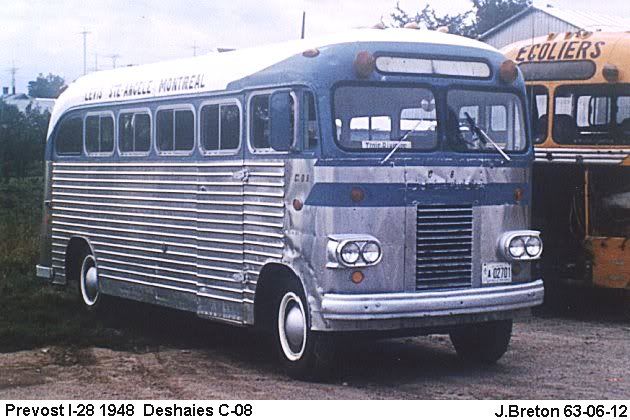 |
|
| Back to top |
|
 |
|
|
You cannot post new topics in this forum
You cannot reply to topics in this forum
You cannot edit your posts in this forum
You cannot delete your posts in this forum
You cannot vote in polls in this forum
You can attach files in this forum
You can download files in this forum
|
Powered by phpBB © 2001, 2005 phpBB Group
|

















